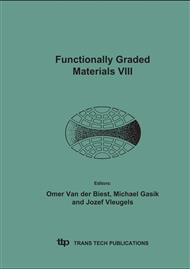p.255
p.261
p.267
p.273
p.281
p.287
p.293
p.299
p.305
Control of Grading Structure and Thermal Conductivity of Wood by Compressing Process
Abstract:
Compressed wood has different grading structure in an annual ring from one of natural wood. This paper treats the relationship between grading structures and effective thermal conductivity of natural and compressed woods. The Lorentz function and the power function are assumed as grading patterns of thermal conductivity. The grading thermal conductivity shows smaller effective thermal conductivity than the homogeneous wood with same average density. The sharper grading pattern gives much smaller effective thermal conductivity. The grading pattern of compressed wood is assumed as a model with locally compressed region. The calculated effective thermal conductivity by the model agrees with the measured thermal conductivity.
Info:
Periodical:
Pages:
281-286
Citation:
Online since:
August 2005
Authors:
Price:
Сopyright:
© 2005 Trans Tech Publications Ltd. All Rights Reserved
Share:
Citation:


